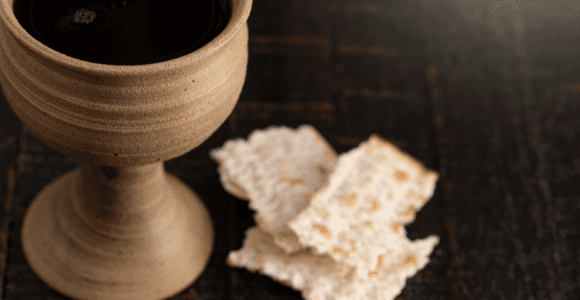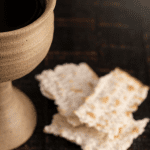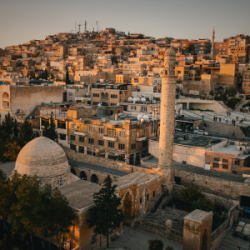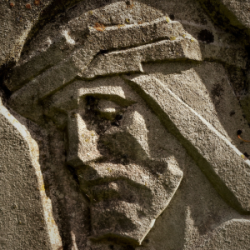Welcome readers! Please subscribe through the button on the right.
(Read this series from its beginning here.)

Again, William’s work leads me to the tension in this week’s passage. Jesus’ last meal in the gospels seems to lead Jesus followers to glorify the cross through the rite of the Eucharist and by glorifying the suffering of the exploited, render their suffering and exploitation sacred.
But as with everything in our sacred text, it all depends on how we choose to interpret the story.
The early Jesus community was not monolithic in how they remembered and interpreted Jesus’ last meal with his disciples. Paul transformed the last supper into a ritual reenactment of Jesus’ broken body and shed blood (see 1 Corinthians 11:23-26), but there were many Jesus followers who didn’t connect the last supper with the passion of Jesus at all, so much so that the first Christian document to explicitly instruct Jesus followers in celebrating the last supper doesn’t mention the passion of Jesus. This document is the Didache. To the best of our knowledge it was composed at the end of the 1st Century or the beginning of the 2nd Century. In it we read:
“Concerning eucharist, this is how you are to conduct it:
First, concerning the cup, ‘We thank you, our Father, for the sacred vine of David, your child, whom you made know to us through Jesus, your child. To you be glory forever.’
Then concerting the fragments of bread: ‘We thank you, our Father, for the life and knowledge that you made known to us through Jesus, your child. To you be glory forever. Just as this loaf was scattered upon the mountains but was gathered into unity, so your church should be gathered from the ends of the earth into your domain. Yours is the glory and the power through Jesus Christ forever.’
No one is to eat or drink from your eucharist except those baptized in the name of the Lord. Recall what the Lord said about this: ‘Don’t throw what is sacred to dogs.” (Didache 9:1-5)
This tradition has led quite a few modern Christians to reinterpret how they memorialize Jesus’ last supper, especially at this time of year when our attention is drawn to it once again. Many Christians today, given what we just read in the Didache, see Jesus’ last supper as the same kind of meal he frequently ate with his disciples and with anyone else who desired to eat with them. Jesus’ open table practice in a culture where whom one ate with had social and political meaning was another example of the inclusiveness he practiced every day. Most scholars today believe that the earliest rituals around Jesus’ last supper took the form we see described in the Didache. The supper was later attached to Jesus’ death as we read in Paul (1 Corinthians 11:23-26), a connection that is then picked up by Mark, Matthew, and in our passage in Luke. In John’s gospel, however, Jesus’ last supper is not associated with the imagery of his death (the passion) but rather with images of his life.
Whereas Mark and Matthew follow Paul’s eucharist order (bread then cup), in our passage this week from Luke, we see signs of early Jesus followers memorializing his last supper both ways: we see both the form found in the Didache and the form found in Paul blended together. This would make sense as Luke’s gospel repeatedly attempts to tell the Jesus story in a way that provides a big tent view of following Jesus. Luke is telling a narrative so that it can be valued by the largest number of Jesus followers. Regardless of which Jesus community readers belonged to, they could nonetheless find what they believed to be meaningful and sacred in Luke’s version of Jesus story.
So let’s take a look at our passage once again.
First, the form found in the Didache:
“’For I tell you, I will not eat it again until it finds fulfillment in the kingdom of God.’ After taking the cup, he gave thanks and said, ‘Take this and divide it among you. For I tell you I will not drink again from the fruit of the vine until the kingdom of God comes.’ And he took bread, gave thanks and broke it, and gave it to them’”
Then the form found in Paul:
“And he took bread, gave thanks and broke it, and gave it to them, saying, ‘This is my body given for you; do this in remembrance of me.’ In the same way, after the supper he took the cup, saying, ‘This cup is the new covenant in my blood, which is poured out for you.’”
Because Luke’s trying to include both forms, Luke’s version of the last supper is the only version to include two cups. In the Didache’s order, you have cup then bread. In Paul’s order, you have bread then cup. And in Luke, which blends both ways of memorializing Jesus last supper, we have a cup (Didache), then bread (Didache and Paul), then a cup again (Paul). Mark and Matthew repeat the form found in Paul, and thus only have one cup.
Why all this “nerding out” over the story detail differences in the gospels, Paul, and the Didache? What’s the point?
That’s next.
(Read Part 3)













